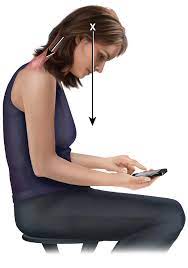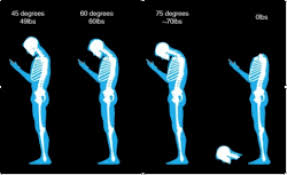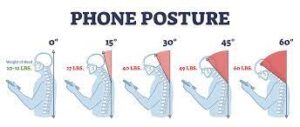

In today’s digital age, our cellphones have become an extension of ourselves.
While they make our lives infinitely easier, there is one thing they are not doing any favors for—our posture.
You might have heard about “tech neck,” the modern-day ailment of forward head posture caused by spending hours looking down at our screens.
But how exactly does cellphone screen positioning contribute to poor neck posture???
In this article, we shall analyze how phone positioning impacts our neck health, examine the mechanics of forward head posture, and offer simple solutions for healthier phone use.
In This Article:
- Understanding “Tech Neck” and Forward Head Posture
- How Screen Position Affects Neck Muscles
- The Mechanics of Forward Head Tilt
- Real-Life Examples of Neck Strain from Cellphone Use
- Solutions for Better Neck Posture While Using Your Phone
- Conclusion: Healthier Screen Habits for Neck Health
Understanding “Tech Neck” and Forward Head Posture
“Tech neck” is the term given to neck pain and stiffness that occurs from constantly looking down at our phones, tablets, and other screens.
This posture issue is more than just a minor annoyance; it has real consequences.
According to research published in the Journal of Physical Therapy Science, bending your head forward increases strain on your neck exponentially.
For example, holding your head at a 15-degree angle places about 27 pounds of force on the neck, while a 60-degree tilt can place up to 60 pounds of strain on the cervical spine.
Imagine holding a heavy bag on your neck every day—this is the effect “tech neck” can have on your body.
Dr. Kenneth Hansraj’s study, published in Surgical Technology International, is often cited for detailing how different degrees of head tilt impact neck strain.
The study explains how each additional degree of tilt places increased weight on the cervical spine, leading to potential issues like chronic neck pain, stiffness, and even spinal degeneration over time.
How Screen Position Affects Neck Muscles?
When you hold your phone at a low angle, like in your lap or waist-level, it naturally requires you to look down, which places the head in a forward position.
This forward tilt pulls the head out of alignment with the spine, placing strain on the muscles at the back of the neck, particularly the trapezius, levator scapulae, and suboccipital muscles.
A study in Applied Ergonomics found that prolonged forward head posture can lead to muscle imbalances, with the muscles at the front of the neck becoming weaker and those at the back becoming overly tight.
This imbalance can make maintaining an upright posture even harder when not using your phone.
Over time, this leads to a chronic condition where the head remains in a forward position, even when you’re not using your device.
The Mechanics of Forward Head Tilt
When you look down at your phone, you are essentially breaking the natural curve of your cervical spine.
Normally, the neck has a gentle curve that helps absorb shock and supports the weight of your head.
When you tilt your head forward, this curve flattens, placing additional stress on the neck’s joints and ligaments.
According to the Journal of Spine Surgery, a flattened or reversed cervical curve caused by forward head posture is associated with an increased risk of neck pain, disc herniation, and even nerve compression.
The body is not designed to support this constant strain, and it compensates by engaging additional muscles in the upper back, leading to discomfort in the shoulders and upper back as well.
This is why prolonged cellphone use at poor angles can lead to soreness not only in the neck but also in the shoulders and upper back.
Essentially, every time you look down at your phone, you are creating a ripple effect that impacts your entire upper body posture.
Real-Life Examples of Neck Strain from Cellphone Use
Let’s take Emma, a 32-year-old marketing professional who spends hours on her phone, checking emails and social media.
After months of constant phone usage, she began to notice nagging pain in her neck and upper back.
Her doctor explained that she had developed a mild case of text neck and she needed best forward head posture fix, exacerbated by the hours she spent looking down at her phone.
Then there’s Jake, a college student who spends a lot of time studying and scrolling through his phone while sitting on his bed.
He found that his neck was getting sore by the end of the day, and he even developed tension headaches.
A physical therapist pointed out that his posture, specifically looking down at his phone all day, was a likely cause of his discomfort.
Jake adjusted by propping his phone on a stack of books to keep it closer to eye level, which significantly reduced his neck pain.
These real-life scenarios illustrate that the impact of poor cellphone screen positioning is not just theoretical; it is affecting people’s daily lives and comfort.
Solutions for Better Neck Posture While Using Your Phone
The good news is, there are simple solutions to avoid tech neck and protect your posture:
Hold Your Phone at Eye Level: This one’s easier said than done, but holding your phone closer to eye level can make a world of difference. It keeps your head aligned with your spine, reducing the strain on your neck muscles.
Take Regular Breaks: Try the “20-20-20 rule”: every 20 minutes, look at something 20 feet away for 20 seconds. This practice helps relax your eye muscles and gives your neck a break from a fixed position.
Use Voice Commands When Possible: Instead of typing out everything, consider using voice commands or a voice-to-text feature, especially for longer tasks. This can reduce the time spent looking down at your phone.
Stretch Your Neck and Shoulders: Regular stretching can help relieve the muscle tension caused by tech neck. Simple exercises such as neck tilts, can improve flexibility and reduce tightness.
Invest in Ergonomic Accessories: Some phone stands and holders can elevate your screen, making it easier to keep your head in a neutral position. By lifting the screen up, you will naturally avoid looking down as often.
Practice Good Posture: Keep your back straight and your shoulders relaxed. When you are using your phone, make a conscious effort to avoid slouching. Good posture not only helps with neck pain but also improves breathing and circulation.
Healthier Screen Habits for Neck Health
As we spend more time on our phones, our screen positioning can play a bigger role in our health than we might realize.
Holding our phones too low may feel natural, but it can lead to significant strain on the neck and even create a habitual forward head posture that impacts our daily comfort and health.
Being aware of how you position your cellphone screen is a small change that can make a big difference in your physical well-being.
Implementing some of the simple solutions mentioned—like holding your phone higher, taking breaks, and practicing good posture—can go a long way toward minimizing the impact of tech neck.
After all, we don’t have to give up our cellphones; we just have to be smarter about how we use them.
References:


